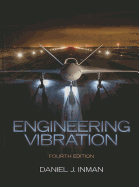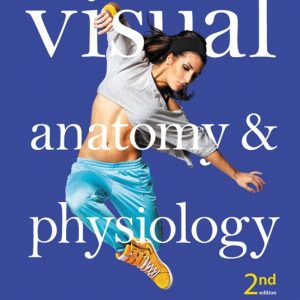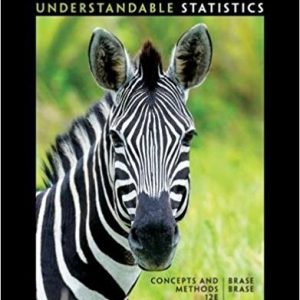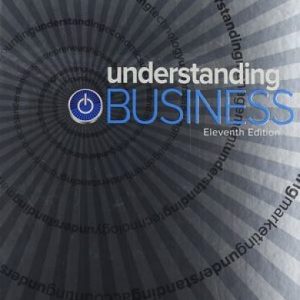This is completed downloadable of Solutions Manual for Engineering Vibration 4th by Inman 0132871696

Product Details:
- ISBN-10 : 0132871696
- ISBN-13 : 978-0132871693
- Author:
Intended for use in one/two-semester introductory courses in vibration for undergraduates in Mechanical Engineering, Civil Engineering, Aerospace Engineering and Mechanics. This text is also suitable for readers with an interest in Mechanical Engineering, Civil Engineering, Aerospace Engineering and Mechanics.
Serving as both a text and reference manual, Engineering Vibration, 4e, connects traditional design-oriented topics, the introduction of modal analysis, and the use of MATLAB, Mathcad, or Mathematica. The author provides an unequaled combination of the study of conventional vibration with the use of vibration design, computation, analysis and testing in various engineering applications.
Table of Content:
- 1 Introduction to Vibration and the Free Response
- 1.1 Introduction to Free Vibration
- Example 1.1.1
- Solution
- 1.1.1 The Spring–Mass Model
- Example 1.1.2
- Solution
- Example 1.1.3
- Solution
- Example 1.1.4
- Solution
- 1.2 Harmonic Motion
- Example 1.2.1
- Solution
- Example 1.2.2
- Solution
- Example 1.2.3
- Solution
- 1.3 Viscous Damping
- 1.3.1 Underdamped Motion
- 1.3.2 Overdamped Motion
- 1.3.3 Critically Damped Motion
- Example 1.3.1
- Solution
- Example 1.3.2
- Solution
- Example 1.3.3
- Solution
- 1.4 Modeling and Energy Methods
- Example 1.4.1
- Solution
- Example 1.4.2
- Solution
- Example 1.4.3
- Solution
- Example 1.4.4
- Solution
- Example 1.4.5
- Solution
- Example 1.4.6
- Solution
- Example 1.4.7
- Solution
- Example 1.4.8
- Solution
- 1.5 Stiffness
- Example 1.5.1
- Solution
- Example 1.5.2
- Solution
- Example 1.5.3
- Solution
- Example 1.5.4
- Solution
- Example 1.5.5
- Solution
- Example 1.5.6
- Solution
- 1.6 Measurement
- Example 1.6.1
- Solution
- Example 1.6.2
- Solution
- Example 1.6.3
- Solution
- 1.7 Design Considerations
- Example 1.7.1
- Solution
- Example 1.7.2
- Solution
- Example 1.7.3
- Solution
- 1.8 Stability
- Example 1.8.1
- Solution
- Example 1.8.2
- Solution
- 1.9 Numerical Simulation of the Time Response
- Example 1.9.1
- Solution
- Example 1.9.2
- Solution
- Example 1.9.3
- Solution
- Example 1.9.4
- Solution
- 1.10 Coulomb Friction and the Pendulum
- Example 1.10.1
- Solution
- Example 1.10.2
- Solution
- Example 1.10.3
- Solution
- Example 1.10.4
- Solution
- Problems
- Section 1.1 (Problems 1.1 through 1.26)
- Section 1.2 (Problems 1.27 through 1.40)
- Section 1.3 (Problems 1.41 through 1.64)
- Section 1.4 (Problems 1.65 through 1.81)
- Section 1.5 (Problems 1.82 through 1.93)
- Section 1.6 (Problems 1.94 through 1.101)
- Section 1.7 (Problems 1.102 through 1.110, also see Problem Section 1.5 )
- Section 1.8 (Problems 1.111 through 1.115)
- Section 1.9 (Problems 1.116 through 1.123)
- Section 1.10 (Problems 1.124 through 1.136)
- MATLAB® Engineering Vibration Toolbox
- Toolbox Problems
- 2 Response to Harmonic Excitation
- 2.1 Harmonic Excitation of Undamped Systems
- Example 2.1.1
- Solution
- Example 2.1.2
- Solution
- Example 2.1.3
- Solution
- Example 2.1.4
- Solution
- 2.2 Harmonic Excitation of Damped Systems
- Example 2.2.1
- Solution
- Example 2.2.2
- Solution
- Example 2.2.3
- Solution
- Example 2.2.4
- Solution
- Example 2.2.5
- Solution
- 2.3 Alternative Representations
- 2.3.1 Geometric Method
- 2.3.2 Complex Response Method
- Example 2.3.1
- Solution
- 2.3.3 Transfer Function Method
- Example 2.3.2
- Solution
- Example 2.3.3
- Solution
- 2.4 Base Excitation
- Example 2.4.1
- Solution
- Example 2.4.2
- Solution
- Example 2.4.3
- Solution
- 2.5 Rotating Unbalance
- Example 2.5.1
- Solution
- Example 2.5.2
- Solution
- 2.6 Measurement Devices
- Example 2.6.1
- Solution
- 2.7 Other Forms of Damping
- Example 2.7.1
- Solution
- Example 2.7.2
- Solution
- Example 2.7.3
- Solution
- 2.8 Numerical Simulation and Design
- Example 2.8.1
- Solution
- Example 2.8.2
- Solution
- 2.9 Nonlinear Response Properties
- Example 2.9.1
- Solution
- Example 2.9.2
- Solution
- Problems
- Section 2.1 (Problems 2.1 through 2.19)
- Section 2.2 (Problems 2.20 through 2.38)
- Section 2.3 (Problems 2.39 through 2.44)
- Section 2.4 (Problems 2.45 through 2.60)
- Section 2.5 (Problems 2.61 through 2.68)
- Section 2.6 (Problems 2.69 through 2.72)
- Section 2.7 (Problems 2.73 through 2.89)
- Section 2.8 (Problems 2.90 through 2.96)
- Section 2.9 (Problems 2.97 through 2.102)
- MATLAB® Engineering Vibration Toolbox
- Toolbox Problems
- Chapter 3 General Forced Response
- 3.1 Impulse Response Function
- Example 3.1.1
- Solution
- Example 3.1.2
- Solution
- Example 3.1.3
- Solution
- Example 3.1.4
- Solution
- 3.2 Response to an Arbitrary Input
- Example 3.2.1
- Solution
- Example 3.2.2
- Solution
- Example 3.2.3
- Solution
- Example 3.2.4
- Solution
- 3.3 Response to an Arbitrary Periodic Input
- Example 3.3.1
- Solution
- Example 3.3.2
- Solution
- 3.4 Transform Methods
- Example 3.4.1
- Solution
- Example 3.4.2
- Solution
- Example 3.4.3
- Solution
- Example 3.4.4
- Solution
- Example 3.4.5
- Solution
- 3.5 Response to Random Inputs
- Example 3.5.1
- Solution
- Example 3.5.2
- Solution
- 3.6 Shock Spectrum
- Example 3.6.1
- Solution
- 3.7 Measurement via Transfer Functions
- 3.8 Stability
- Example 3.8.1
- Solution
- Example 3.8.2
- Solution
- 3.9 Numerical Simulation of the Response
- Example 3.9.1
- Solution
- Example 3.9.2
- Solution
- Example 3.9.3
- Solution
- Example 3.9.4
- Solution
- 3.10 Nonlinear Response Properties
- Example 3.10.1
- Solution
- Example 3.10.2
- Solution
- Problems
- Section 3.1 (Problems 3.1 through 3.17)
- Section 3.2 (Problems 3.18 through 3.29)
- Section 3.3 (Problems 3.30 through 3.38)
- Section 3.4 (Problems 3.39 through 3.43)
- Section 3.5 (Problems 3.44 through 3.48)
- Section 3.6 (Problems 3.49 through 3.50)
- Section 3.7 (Problems 3.51 through 3.58)
- Section 3.8 (Problems 3.59 through 3.64)
- Section 3.9 (Problems 3.65 through 3.72)
- Section 3.10 (Problems 3.73 through 3.79)
- MATLAB Engineering Vibration Toolbox
- Toolbox Problems
- 4 Multiple-Degree-of-Freedom Systems
- 4.1 Two-Degree-of-Freedom Model (Undamped)
- Example 4.1.1
- Example 4.1.2
- Solution
- Example 4.1.3
- Solution
- Example 4.1.4
- Solution
- Example 4.1.5
- Solution
- Example 4.1.6
- Solution
- Example 4.1.7
- Solution
- 4.2 Eigenvalues and Natural Frequencies
- Example 4.2.1
- Solution
- Example 4.2.2
- Solution
- Example 4.2.3
- Solution
- Example 4.2.4
- Solution
- Example 4.2.5
- Example 4.2.6
- Solution
- 4.3 Modal Analysis
- Example 4.3.1
- Solution
- Example 4.3.2
- Solution
- 4.4 More than Two Degrees of Freedom
- Example 4.4.1
- Example 4.4.2
- Solution
- Mode Summation Method
- Example 4.4.3
- Solution
- Nodes of a Mode
- Rigid-Body Modes
- Example 4.4.4
- Solution
- 4.5 Systems With Viscous Damping
- Example 4.5.1
- Solution
- Example 4.5.2
- Solution
- 4.6 Modal Analysis of the Forced Response
- Example 4.6.1
- Solution
- Resonance
- Example 4.6.2
- Solution
- Forced Response via Mode Summation
- 4.7 Lagrange’s Equations
- Example 4.7.1
- Solution
- Example 4.7.2
- Solution
- Example 4.7.3
- Solution
- Damping
- Example 4.7.4
- Solution
- 4.8 Examples
- Example 4.8.1
- Solution
- Example 4.8.2
- Solution
- Example 4.8.3
- Solution
- 4.9 Computational Eigenvalue Problems for Vibration
- Dynamically Coupled Systems
- Example 4.9.1
- Solution
- Using Codes
- Example 4.9.2
- Solution
- Example 4.9.3
- Solution
- Various Eigenvalue Problems
- Damped Systems
- Example 4.9.4
- Solution
- 4.10 Numerical Simulation of the Time Response
- Example 4.10.1
- Solution
- Example 4.10.2
- Solution
- Example 4.10.3
- Solution
- Problems
- Section 4.1 (Problems 4.1 through 4.19)
- Section 4.2 (Problems 4.20 through 4.35)
- Section 4.3 (Problems 4.36 through 4.46)
- Section 4.4 (Problems 4.47 through 4.59)
- Section 4.5 (Problems 4.60 through 4.72)
- Section 4.6 (Problems 4.73 through 4.83)
- Section 4.7 (Problems 4.84 through 4.87)
- Section 4.9 (Problems 4.88 through 4.98)
- Section 4.10 (Problems 4.99 through 4.106)
- MATLAB Engineering Vibration Toolbox
- Toolbox Problems
- Chapter 5 Design for Vibration Suppression
- 5.1 Acceptable Levels of Vibration
- Example 5.1.1
- Solution
- Example 5.1.2
- Solution
- 5.2 Vibration Isolation
- Example 5.2.1
- Solution
- Example 5.2.2
- Solution
- Example 5.2.3
- 5.3 Vibration Absorbers
- Example 5.3.1
- Solution
- Example 5.3.2
- Solution
- 5.4 Damping in Vibration Absorption
- 5.5 Optimization
- Example 5.5.1
- Solution
- Example 5.5.2
- Solution
- 5.6 Viscoelastic Damping Treatments
- Example 5.6.1
- Solution
- Example 5.6.2
- Solution
- 5.7 Critical Speeds of Rotating Disks
- Example 5.7.1
- Solution
- Example 5.7.2
- Solution
- Problems
- Section 5.1 (Problems 5.1 through 5.5)
- Section 5.2 (Problems 5.6 through 5.26)
- Section 5.3 (Problems 5.27 through 5.36)
- Section 5.4 (Problems 5.37 through 5.52)
- Section 5.5 (Problems 5.53 through 5.66)
- Section 5.6 (Problems 5.67 through 5.73)
- Section 5.7 (Problems 5.74 through 5.80)
- MATLAB Engineering Vibration Toolbox
- Toolbox Problems
- 6 Distributed-Parameter Systems
- 6.1 Vibration of a String or Cable
- Example 6.1.1
- Solution
- 6.2 Modes and Natural Frequencies
- Example 6.2.1
- Example 6.2.2
- Example 6.2.3
- Solution
- 6.3 Vibration of Rods and Bars
- Example 6.3.1
- Solution
- Example 6.3.2
- Solution
- 6.4 Torsional Vibration
- Example 6.4.1
- Solution
- 6.5 Bending Vibration of a Beam
- Euler–Bournoulli Beam Theory
- Example 6.5.1
- Solution
- Timoshenko Beam Theory
- Example 6.5.2
- Solution
- 6.6 Vibration of Membranes and Plates
- Example 6.6.1
- Solution
- 6.7 Models of Damping
- Example 6.7.1
- Solution
- Example 6.7.2
- 6.8 Modal Analysis of the Forced Response
- Example 6.8.1
- Solution
- Example 6.8.2
- Solution
- Example 6.8.3
- Solution
- Problems
- Section 6.2 (Problems 6.1 through 6.8)
- Section 6.3 (Problems 6.9 through 6.31)
- Section 6.4 (Problems 6.32 through 6.41)
- Section 6.5 (Problems 6.42 through 6.49)
- Section 6.6 (Problems 6.50 through 6.54)
- Section 6.7 (Problems 6.55 through 6.65)
- Section 6.8 (Problems 6.66 through 6.70)
- MATLAB Engineering Vibration Toolbox
- Toolbox Problems
- Chapter 7 Vibration Testing and Experimental Modal Analysis
- 7.1 Measurement Hardware
- 7.2 Digital Signal Processing
- Example 7.2.1
- 7.3 Random Signal Analysis in Testing
- 7.4 Modal Data Extraction
- Example 7.4.1
- Solution
- 7.5 Modal Parameters by Circle Fitting
- 7.6 Mode Shape Measurement
- Example 7.6.1
- Example 7.6.2
- Solution
- 7.7 Vibration Testing for Endurance and Diagnostics
- Example 7.7.1
- Solution
- 7.8 Operational Deflection Shape Measurement
- Problems
- Section 7.2 Problems (7.1 through 7.5)
- Section 7.3 (Problems 7.6 through 7.9)
- Section 7.4 (Problems 7.10 through 7.19)
- Section 7.5 (Problems 7.20 through 7.24)
- Section 7.6 (Problems 7.25 through 7.31)
- MATLAB Engineering Vibration Toolbox
- Toolbox Problems
- 8 Finite Element Method
- 8.1 Example: The Bar
- Example 8.1.1
- Solution
- 8.2 Three-Element Bar
- Example 8.2.1
- Solution
- Example 8.2.2
- Solution
- 8.3 Beam Elements
- Example 8.3.1
- Solution
- Example 8.3.2
- Example 8.3.3
- Solution
- 8.4 Lumped-Mass Matrices
- Example 8.4.1
- Solution
- 8.5 Trusses
- 8.6 Model Reduction
- Example 8.6.1
- Problems
- Section 8.1 (Problems 8.1 Through 8.7)
- Section 8.2 (Problems 8.8 Through 8.20)
- Section 8.3 (Problems 8.21 Through 8.33)
- Section 8.4 (Problems 8.34 Through 8.43)
- Section 8.5 (Problems 8.44 Through 8.49)
- Section 8.6 (Problems 8.50 Through 8.54)
- MATLAB Engineering Vibration Toolbox
- Toolbox Problems
- A Complex Numbers and Functions
- B Laplace Transforms
- C Matrix Basics
- D The Vibration Literature
- Introductory Texts
- Advanced Texts
- Periodicals
- Journals
- E List of Symbols
- CHAPTER 1
- CHAPTER 2
- CHAPTER 3
- CHAPTER 4
- Chapter 5
- CHAPTER 6
- CHAPTER 7
- CHAPTER 8
- F Codes and Websites
- G Engineering Vibration Toolbox and Web Support
- Web Support
- MATLAB Engineering Vibration Toolbox
- References
- Answers to Selected Problems
- Index
- A
- B
- C
- D
- E
- F
- G
- H
- I
- K
- L
- M
- N
- O
- P
- Q
- R
- S
- T
- U
- V
- W
- Y
- Z





